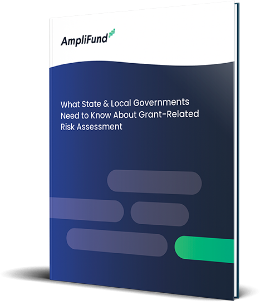Part 2: Efficient Solutions
Coordinating across departments, tracking complex compliance requirements, and balancing multiple grants can make the challenges of effective grant management seem endless. Many state offices find themselves asking: Are we maximizing our funding opportunities? Are we meeting all requirements? Are subrecipients properly managing and reporting on grant funds? Can we effectively monitor our programs?
If these questions sound familiar, you’re not alone. In Part 1 of this series , we looked at the five most common state grant management challenges identified by the Government Accountability Office and Data Foundation back in 2018. The tough news is that nearly seven years later, these still persist for most grant offices.
The good news? There are steps that will lead to significant improvements. Below, we share best practices and efficient tips for systematically addressing each challenge to improve your state’s processes and optimize outcomes.
1. Internal Controls and Process Management
Challenge: Lack of Internal Controls
States often struggle to implement and maintain effective control systems across their grant programs and subrecipient networks, which can lead to increased risk of errors and compliance issues. This challenge has grown even more acute with the introduction of new funding streams and requirements. When subrecipients follow different processes for similar grants, maintaining consistent controls becomes nearly impossible, amplifying compliance risks across the entire grant portfolio.
Solution: Audit your current grant management processes to establish strong internal controls
To address the lack of internal controls, start by evaluating your current processes. Do the methods you’ve implemented appear to be working internally and with your subrecipients? Do they need to be updated to reflect current requirements? Regularly auditing the effectiveness of your grant management processes will enable your team to be more efficient and create capacity as the project progresses.
Using process mapping tools, document your current processes to better understand shortcomings and pinpoint specific improvements. From here, build out tasks that include associated documents and deliverables, key parties, and communication methods for each step. This mapping should include your subrecipient monitoring processes to confirm consistent oversight across all grant programs.
Make sure you document any and all changes to these processes and keep this information in a centralized location. This practice becomes especially valuable when using automated systems that can track changes and maintain audit trails. This documentation process will not only save time later but will also keep the project on track if staff turnover or other unexpected challenges occur.
Resource: Gain an understanding of what internal controls are essential for grant management and how to get started with our on-demand webinar, Creating Buy-In for System-Wide Internal Controls
2. Role Definition and Team Structure
Challenge: Lack of allocation of duties
Without clear role definitions and responsibilities, grant management becomes inefficient and prone to errors. Many states face challenges in coordinating efforts not only across departments but also with their subrecipients while maintaining consistent oversight of both.
Solution: Clearly define team roles and responsibilities
To solve the challenge of unclear role allocation, create a dedicated team structure. Assembling a Central Grants Office with key roles is one of the first steps leadership can take to ensure all responsibilities are allocated appropriately to the right team members at the right time. The main goals of a Central Grants Office are to provide organizational leadership and oversight over grant policy, evaluation, and training, as well as expertise on grant management systems and to streamline processes.
Modern grant offices often include specialized roles for compliance monitoring, data analysis, and subrecipient oversight to meet current requirements. If you structure your team in a way that works for your agency, you will create an environment made up of key resources who can make and drive central decisions.
By creating a review process that requires specific expenditures be approved and documented internally, you will have a more accurate picture of your project’s budget adherence and overall progress. This is especially important when monitoring subrecipient spending and performance. A technology solution, such as a grant management system (GMS), can help automate these approval processes and maintain clear documentation of decisions.
After team members have agreed to play a role in the Central Grants Office, it’s time to begin centralization practices. These practices include establishing standard communication, reporting, and decision-making procedures across all grant programs and subrecipient relationships.
Resource: Take your team through the role assignment exercises in our Designing Processes to Achieve Goals Workbook
3. Compliance Management
Challenge: Issues with non-compliance
As federal requirements become more complex, states find it increasingly difficult to maintain compliance across all grant programs and subrecipient networks. This challenge is exacerbated when managing multiple funding streams with differing requirements and making sure each subrecipient properly documents and reports their grant activities.
Solution: Centralize your grant management practices to maintain compliance
Document, document, document. In order to effectively avoid non-compliance, monitor program performance, and plan for a successful audit, you want to ensure you have documented everything throughout the life of the grant.
When we say “everything,” we really do mean everything. For example, if you or your subrecipients have expenditures that weren’t properly documented, even if they were allowable, this could be considered a misuse of funds. The way to avoid this is to keep everything related to the grant documented and in a centralized location.
Grant management systems make this easier by providing a single platform for all grant-related information, automated compliance checks, calendars, and subrecipient monitoring tools. With this system everyone who touches any aspect of the grant program has a repository for the data and documents they generate, and those who oversee the program then have direct access to the information they need when they need it.
Centralizing your grant-related information, including your policies, processes, and programmatic data requirements and standards, will improve organizational transparency and compliance. Centralization also helps ensure that your program’s records are readily accessible for auditing purposes, effective closeout, and, most importantly, monitoring your outcomes.
Resource: Learn the steps to effectively centralize your grant-related data and processes with our Grant Management Centralization Guide
4. Progress Monitoring and Reporting
Challenge: Improper monitoring of progress
Many states struggle to track and report on grant performance effectively, especially when collecting performance data across numerous programs, agencies, and subrecipients–each potentially using different tracking methods. Without proper monitoring, programs can quickly fall behind on spending and performance targets.
Solution: Establish strong reporting structures
Take this opportunity to create internal policies on reporting to ensure you’re properly monitoring your monthly spend and subrecipient activity. Establishing standard reporting structures will provide financial oversight and can help your organization adhere to a timeline with milestones that can be used for benchmarking.
Implement a policy that requires team members and subrecipients to report back to the grant coordinator or manager on a monthly basis. This will allow you to catch problems early. For example, if you’re unsure if an expenditure can be accounted for, monthly reporting will allow you time to get in touch with your Program Officer or Manager, who should be able to help clarify this for you. (This also addresses the next challenge, award closeout, as it provides the red flags needed to identify issues with enough time to address them.)
If you have a grants management system, use it to automate this process and provide real-time visibility into program performance and spending. If you don’t have a GMS, you will need to create a system or a structure for this process that will need to be documented.
Resource: Access our Reporting & Compliance Toolkit to establish reporting best practices
As you track expenditures, be sure to have backup information required by the Uniform Grant Guidance (UGG) for auditing purposes and to ensure you have a complete grant record. This will pay dividends throughout the life of the project, especially during award closeout. Stay current on the latest UGG requirements with the 2024 Uniform Grant Guidance Update and the OMB’s 2024 Compliance Supplement Updates.
5. Grant Closeout
Challenge: Lack of timeliness for grant closeout
Closeout delays are common across state grant programs, often due to incomplete documentation or unresolved financial issues. For states managing multiple subrecipients, this challenge is amplified as each subrecipient must complete their own closeout process before the state can finalize theirs. These delays can impact future funding and lead to audit findings.
Solution: Implement a grant management system for timely grant closeout
In theory, a grant award closeout is just a repackaged version of the information you already have on hand after completing your reporting requirements throughout the life of your grant. As we all know, in reality, this process is not as seamless as the description suggests.
Effectively closing out an award depends on how thoroughly you managed the award during the program and the efficiency of your documentation processes. Additionally, there may have been challenges that you didn’t anticipate during your program, such as staff turnover, that could complicate your ability to close out efficiently and effectively.
The bottom line is that if the closeout process for an award doesn’t begin until the award is coming to a close, it makes sense that grant managers will struggle to gather all required documentation and complete final reporting on time. This is especially true when juggling several grant programs with different end dates and subrecipients with their own processes in place.
This is why it is critical to start the award closeout process as soon as the grant is awarded. With the right steps and systems in place from the start, risks are identified before issues arise, reports are ready with real-time data, documents are centrally stored and accessible, and, ultimately, award closeout is streamlined and simplified.
Resource: Prepare your closeout process as soon as the grant is awarded with our Award Closeout Toolkit
The reality is, delivering the efficiency and compliance changes outlined here is nearly impossible without a system for managing grant programs, documents, budgets, expenditures, recipients, deadlines, etc. This is why it is no surprise that more states are implementing a statewide grant management system.
To find out if a grant management system is the right fit for your state, set up a time with one of our solutions experts for a personalized demo.





